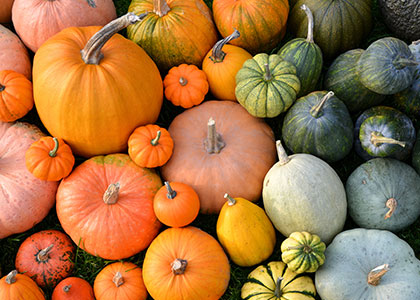
All About Winter Squash
By Claire Georgiou, Reboot Naturopath, B.HSc ND
Winter squash are one of the many reasons to love the season. They provide plenty of antioxidants, beneficial plant compounds and winter-specific nutrients such as vitamin A, which helps us to fight viral infections.
They are high in carotenoids, which are specialized compounds that support respiratory health for the winter months and have shown to protect against certain types of cancer. These squashes are also an excellent source of vitamins A, C, B1, folic acid, potassium and fiber.
With so many different types of winter squash to try, do you know your favorite? Here’s a breakdown of some of the most common varieties you can find at the market.
Butternut Squash
Known as butternut pumpkin as well, this squash is quite popular and one of my personal favorites. Shaped like an elongated pear, it has a pale orange color and the skin can be eaten once cooked. It is a very versatile vegetable that can be roasted, pureed in soup or cubed in dishes such as salads, casseroles, curries, pasta dishes, risotto and anything else you can think of.
How to cook: Preheat oven to 425F. Cut off the bottom and top, slice in half, and scoop out the seeds. Peeling is optional but you can also scrape the roasted squash out of the peel, once cooked. Drizzle oil over the squash, sprinkle salt and pepper and roast on a baking tray until soft for 20 to 30 minutes.
Recipes to enjoy:
- Roasted Butternut Squash
- Creamy, Non-Dairy Butternut Squash Soup
- Simple Roasted Brussels with Pears & Butternut Squash
- Lentil and Butternut Squash Curry
Spaghetti Squash
This oval yellow squash contains a stringy spaghetti-like flesh that has a very mild flavor. Once cooked the squash is very similar to angel hair pasta but its lower in carbohydrates and calories, full of antioxidants and fiber and it’s naturally gluten free.
Once baked, you can fill the inside of the squash with homemade Mexican or Italian flavors and eat it in its ready-made bowl. Another technique is to scrap out the flesh once it’s cooked and place it in a bowl or plate then cover with your desired sauce.
How to cook: Preheat the oven to 400F (200C). Cut the squash in half, scoop out the seeds with a spoon and cook it face-down in a baking dish for 35 to 45 minutes. You can add a little water to the pan or cover it with foil to speed up the cooking process; the steam helps keep surfaces of the squash from drying out and makes the resulting strands of squash incredibly tender. For more details read: How to Cook Spaghetti Squash: A Step by Step Guide
Recipes to enjoy:
- Veggie-Stuffed Spaghetti Squash
- Spaghetti Squash with Avocado “Cream” & Cashew “Ch-eeze” Sauce
- Tomato Basil Spaghetti Squash
Acorn Squash
Also known as pepper squash, acorn often has dark green skin and yellow orange flesh. It also has a golden-and-white variety. As the name indicates, it is shaped like an acorn. It is mostly baked, but it can be steamed, boiled, sautéed or stuffed much like the spaghetti squash.
How to cook: Slice in half, coat in oil, salt and pepper and roast until tender.
Recipes to enjoy:
- Roasted Acorn Squash Stuffed with Mushroom and Sage
- Vegan Spinach & Cranberry Stuffed Acorn Squash
- Lentil & Quinoa Stuffed Acorn Squash
- Acorn Squash & Black Bean Soup
Delicata Squash
You can also call it peanut squash or sweet potato squash. This long, oblong-shaped light yellow squash has green strips and a soft edible skin. It can be roasted with the skin on or cut long ways, seeds scooped out and roasted and stuffed much like the spaghetti squash. This squash isn’t high in carotenoids as the darker coloured squash varieties, but has plenty of fiber and vitamin C.
How to cook: Preheat oven to 400F. Half lengthways and de-seed. Cover squash in oil, salt and pepper and place on a baking tray facing upwards and bake for 40 minutes or until tender. You can then stuff it and reheat it in the oven if desired.
Recipe to enjoy:
Hubbard Squash
One of the largest winter squashes, a hubbard variety can weigh up to 20 pounds with a tear-drop shape. This squash can range in color from orange to darkish blue grey. The skin is very thick while the flesh is light yellow in color with a mild savory and sweet flavor. It’s ideal to mash this one in pies or use it as a puree.
How to Cook: Cook it as you would the spaghetti squash. Roast cut open and then stuff it with your favorite ingredients.
Kabocha Squash
Common here in Australia and used all year round in many dishes, kobocha is also known as the Japanese squash. It has a mild nutty sweet flavor and works well in many types of dishes. This squash has a dark green skin with light green strips and the flesh is a dark orange. It’s a harder squash compared to the others listed. It can be roasted, steamed, boiled and pureed with the skin on or off. (I suggest leaving the skin on for roasting and removed for puree). Once cooked well, the skin is edible though thicker than most squashes.
How to cook: Cut into thick wedges with the skin on, scoop out the seeds and roast in the oven as you would butternut squash.
Recipe to enjoy:
Get more tips on How to Store Your Fall Produce.





